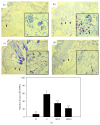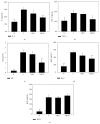Danggui buxue tang inhibits 2,4-dinitrochlorobenzene: induced atopic dermatitis in mice
- PMID: 25861366
- PMCID: PMC4377538
- DOI: 10.1155/2015/672891
Danggui buxue tang inhibits 2,4-dinitrochlorobenzene: induced atopic dermatitis in mice
Abstract
Danggui Buxue Tang (DBT) is a herbal decoction that has been used in Chinese medicine to enhance qi and blood circulation. Previously, we found that DBT can suppress allergy-related asthma in mice, leading us to hypothesize that DBT might ameliorate allergy disease. In this study, we evaluated whether DBT can attenuate atopic dermatitis (AD) symptoms and have an anti-inflammatory effect on AD-like mice. The dorsal skin of female mice was shaved and sensitized cutaneously (skin smear) with 1-chloro-2,4-dinitrobenzene. Mice were then given various doses of DBT from days 14 to 29 cutaneously. DBT treatment suppressed ear swelling and skin inflammation and decreased mast cell and eosinophil infiltration into skin and ear tissue. DBT also inhibited levels of IgE and Th2-associated cytokine levels in serum. These results demonstrate that cutaneous administration of DBT reduced the development of AD-like skin lesions in mice.
Figures








References
-
- Berke R., Singh A., Guralnick M. Atopic dermatitis: an overview. American Family Physician. 2012;86(1):35–42. - PubMed
Grants and funding
LinkOut - more resources
Full Text Sources
Other Literature Sources

